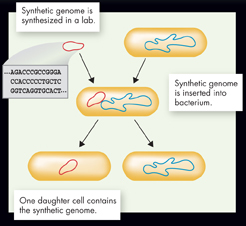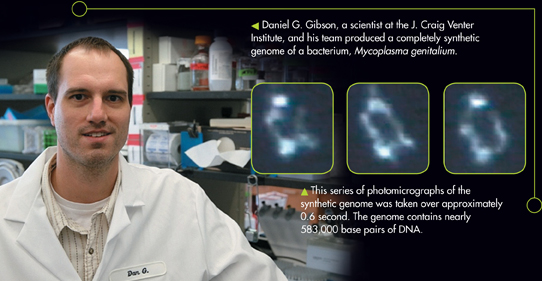Technology & Biology
Artificial Life?
In 2008, scientists at the J. Craig Venter Institute in Rockville, Maryland, produced a synthetic genome with more than half a million DNA base pairs. It may not be long before artificial cells containing similar genomes can be grown in the laboratory. How? First a complete DNA molecule, containing the minimum set of the genetic information needed to keep a cell alive, is produced in the laboratory. Then, that molecule is inserted into a living cell to replace the cell's DNA. The result is a cell whose genome is entirely synthetic. Scientists hope this technique can help them design cells for specific purposes, like capturing solar energy or manufacturing biofuels.
WRITING
How could ethical and societal factors affect the production of synthetic organisms? If you were a scientist working on the latest breakthroughs, how would you address those issues? Describe your ideas in an essay.

▴ Synthesizing a Genome
One way to synthesize life is to replace a cell's genome with an artificial DNA molecule. As a result, cell division may produce a daughter cell containing only the human-made genome.
dTable of Contents
- Formulas and Equations
- Applying Formulas and Equations
- Mean, Median, and Mode
- Estimation
- Using Measurements in Calculations
- Effects of Measurement Errors
- Accuracy
- Precision
- Comparing Accuracy and Precision
- Significant Figures
- Calculating With Significant Figures
- Scientific Notation
- Calculating With Scientific Notation
- Dimensional Analysis
- Applying Dimensional Analysis





